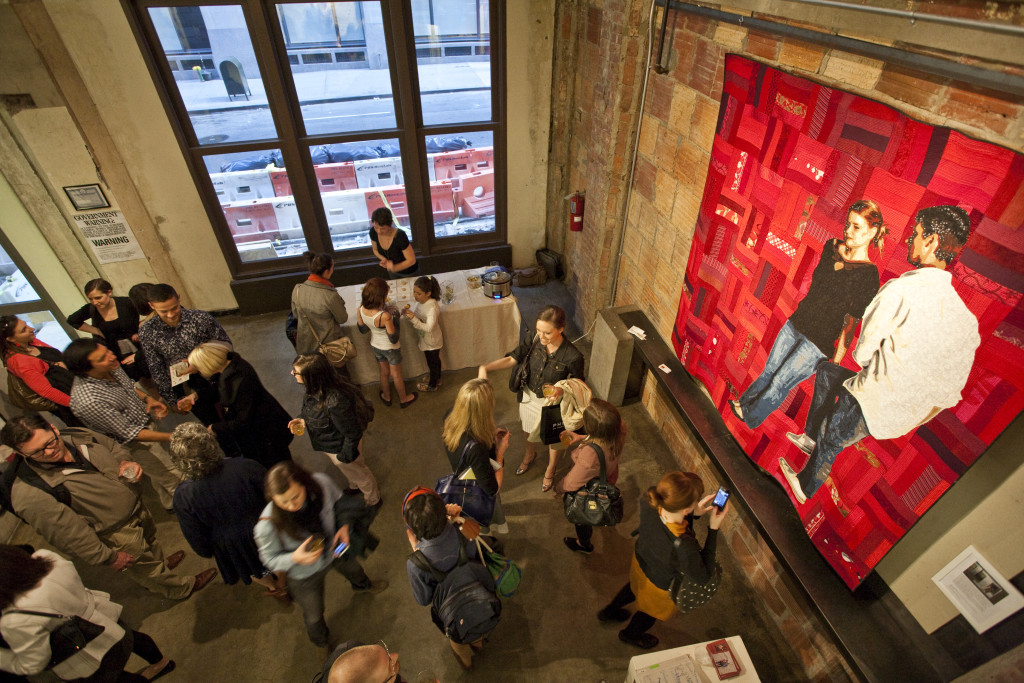Welcome to Moda Fabrics!
Meet Moda designer Luke Haynes
Meet Moda designer Luke Haynes
Carrie introduced you to Luke Haynes back in September, before his fabric was shown at Market. Now that the “big reveal” of his line Dapper has taken place, we thought we’d talk with Luke a bit more.
 Luke at Quilt Market, in front of a quilt made using his Dapper wovens and wearing a shirt in Dapper's Mustang Blue colorway
Luke at Quilt Market, in front of a quilt made using his Dapper wovens and wearing a shirt in Dapper's Mustang Blue colorway
When I called him, Luke was walking on the streets of L.A., where he’s lived for the past two-and-a-half years. (I learned this when I heard a dog barking and asked him if it was his—it wasn’t, but he does have two cats: PBC, which stands for Poo-Butt Coconut, and Grandpa.) Luke moved to California from Seattle in search of more sunshine and a bigger art market. Though he enjoys life in L.A., he leaves frequently for lectures, exhibitions, and teaching gigs.
Luke grew up across the American south, including Alabama and Mississippi, and still calls Asheville, North Carolina, his hometown. Luke’s mom is a chemist and his dad is a storyteller and they met when they were working in a gym in Colorado. Luke went to art school in Winston-Salem and studied architecture in New York City, followed by three years of architectural work. He had been crocheting and knitting most of his life and started making quilts in art school, but it wasn’t until he’d been working in architecture and realized he didn’t really enjoy “working for someone who was working for someone else” that he decided to pursue making quilts for a living. “Architecture was too far removed from actual art and design,” he says.
 Luke's interest in playing with perspective and the sculptural qualities of quilts is apparent in American Context #41 Ben Franklin, viewed here on a bed. The same piece is below, viewed flat on a wall.
Luke's interest in playing with perspective and the sculptural qualities of quilts is apparent in American Context #41 Ben Franklin, viewed here on a bed. The same piece is below, viewed flat on a wall.
Fabric is Luke’s medium of choice for self-expression for a number of reasons, including its sculptural qualities. “If I paint a picture and do a poor job of it, the net gain is zero,” he says. “With a quilt, if it’s not successful there’s still the object you made and it’s tangible. At the end of the day, fabric is something.”
In recent years, Luke’s been working with reclaimed fabrics, often sourced from the community in which he’s teaching. Dapper includes wovens that Luke feels harken to the familiar in the same way that recycled materials do. “There’s a history behind those pattern types and it can be an entry point for something interesting,” he says. “My quilts might include jeans or a shirt and people understand that because they have jeans or a shirt—with my wovens you may understand the history of the weave—there’s a textural reference to historical textiles—but I wanted the colors to be new.” His color palette comes from the world of high design, furniture, and architecture.
In addition to teaching, speaking, and designing fabric, Luke is involved in numerous art projects—he’s participated in at least two exhibitions each month for the past three years—and currently is working on a series of 50 log cabin variations. Creating work in a series enables him to learn what a slight difference can do to a form or pattern. He also finds that creating numerous works based on a theme gives viewers and collectors an understanding of his intent. “A series shows that you’ve taken time and effort to do something on purpose—this show is for me to understand the variations technically and visually, and for viewers to understand them aesthetically.” The exhibition, Log Cabins of Donald Judd, will open in southern California in February. You can see some of the quilts below.
In all his quilts, Luke strives to create work that is interesting from three distances—as far away as you can get, a medium distance, and up close. From a distance it’s easy to see the portraits Luke stitches into many of his quilts, while up close you see the textures and stitches. “I want to make sure all those positions are taken care of, visually and cerebrally,” says Luke.
In addition to Dapper, which will be in stores in April, Luke has other projects in the works, including one called Just Try It that will encourage people who may not have quilted previously to give it a try. We’ll post more about that when it happens. In the meantime, here’s a quote from Luke that quilters can relate to: “Fabric is my medium and it’s my job to wrangle it.”

![[The American Context #4] Benjamin Franklin 100 100](http://blog.modafabrics.com/wp-content/uploads/2015/12/The-American-Context-4-Benjamin-Franklin-100-100-1024x1024.jpg)




Comments